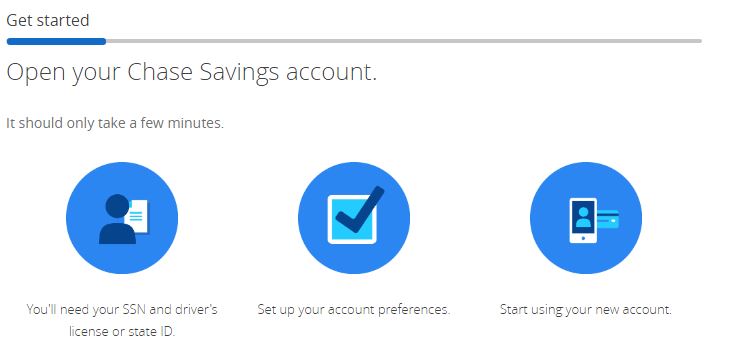
JPMorgan Chase is one of the largest banks in the country, and to keep up with its competitors, usually offer great perks for new account holders. So, if you’re shopping around for a new savings account (or even a new banking experience all together), Chase Bank is a trusted name in the industry that may be worth looking into for your banking needs.
In addition to offering checking accounts, Chase also offers savings accounts with rates comparable to its competitors such as Wells Fargo or Bank of America – but to set themselves above the rest, they usually offer a cash bonus to customers opening a savings account with them for the first time.
What Is A Chase Savings Account ?
Chase currently offers two types of Savings Accounts (Savings and Premier Savings) as a place for customers to stash away any extra funds for anything they want (such as for a big vacation, a one-time big purchase or to save for emergency purposes).
What is the the APY on a Savings Account at Chase?
The current annual percentage yield (APY) is 0.1%. Interest is compounded and credited monthly, based on your daily collected balance.
Do Chase Savings Accounts Have A Service Fee?
Yes, there is a monthly service fee of $5 on the base savings account, while Chase Premier has a $25 monthly fee. But, the monthly fees on these accounts can be waived if you meet certain criteria.
What is the Minimum Deposit to open a savings account at Chase?
- Chase Savings: $25 Minimum
- Premier Savings: $100 Minimum
How Do I Avoid Chase Monthly Fees?
Chase gives their customers a few options to avoid their monthly service charges…
| Chase Savings | Chase Premier Savings | |
| Monthly Service Fee | $5 | $25 |
| How to Avoid The Fee | · Avoid the fee by having a balance at the beginning of each day of $300 or more in this account · OR have at least one repeating automatic transfer of $25 or more from your personal Chase checking account or Chase Liquid Card · OR an account owner who is an individual younger than 18 · OR with a linked Chase personal checking account (excluding Chase High School Checking, Chase College Checking, Chase Secure Checking, Chase Total Checking, and Chase Checking) | · Avoid the fee by having a balance at the beginning of each day of $15,000 or more in this account · OR with a linked Chase Premier Plus Checking or Chase Sapphire Checking |
How Do I Deposit and Withdraw Money From A Savings Account at Chase?
Here are the ways you can deposit and withdraw money from a Chase savings account.
- Cash Deposits / Withdrawal (Deposit at Branch only / Withdraw via Branch or ATM)
- Secondly, Check Deposit / Withdrawal
- Thirdly, Mobile Deposit / Withdrawal
- Then, through Wire Transfers
- and also, via Direct Deposit
What Are Chase Bank’s Account Fees?
Here is a breakdown of fees associated with Chase Bank accounts:
| Type | Fee |
| Monthly Fee | • $5 for Chase Savings • $25 for Chase Premier Savings |
| Non-Chase ATM | $2.50 (inside U.S.) |
| Insufficient Funds | $34 *Note: Chase will not charge an Insufficient Funds Fee if your account balance at the end of the business day is overdrawn by $5 or less • Furthermore, you would not be charged these fees for any item that is $5 or less, even if your account balance at the end of the business day is overdrawn • Also, if Chase returns the same item multiple times, Chase will only charge you one Returned Item Fee for that item within a 30-day period • Moreover, these do not apply to withdrawals made at an ATM |
| Returned Item | $34 |
| Stop Payment | $30 / request |
| Online Stop Payment | $25 / request |
| Deposited item returned or cashed check returned | $12 per item |
| Non-ATM Cash (such as teller at other bank) | 3% of transaction OR $5 – whichever is greater |
| Domestic and International Incoming Wire | $15/transfer or $0 if transfer was sent with help of Chase. |
| Domestic Outgoing Wire | $35/ transfer |
| Online Domestic Outgoing Wire | $25/ transfer |
| Consumer UDS/ FX International Fee | $50/ transfer |
| Consumer Online FX International Fee | $5 per transfer OR $0 per transfer if the amount is equal to $5,000 USD or more |
| Statement Copy | $6 per statement OR $0 if you view or print your statement on chase.com |
| Counter Check | $2 per page |
| Money Order | $5 per check |
| Cashier’s Check | $8 per check |
| Legal Processing | Up to $75 per order |
Note:
*You can avoid overdrawing your account by making a deposit or transferring funds to cover the overdraft before the business day ends. If you deposit a check, this assumes Chase does not place a hold and the check is not returned. Here are the cutoff times for some ways of making a deposit or transferring funds from another Chase account:
- At a branch before it closes
- Or, at an ATM or when transferring money at chase.com / Chase Mobile app before 11pm EST.
What Are The Benefits of A Savings Account at Chase?
- Account sign-up bonuses
- FDIC-Insured
- Access to ~ 5,100 branches and ~16,000 ATMs
- Monthly fee is fairly easy to avoid
- Can be used for overdraft protection
- Also, they offer mobile and online banking available. For instance, via Zelle
- as well as the ability to set up account alerts
- Higher balances may earn a better interest rate
- Also, there is an ability to earn “relationship” rates if you have an accompanying Chase checking account.
- as well as 24/7 customer support online
What Are The Disadvantages of A Chase Savings Account?
- Lower APY/ interest rates compared to online savings accounts
- Opening deposit requirement
- Also, it is important to note that their rates are variable. In other words, they could be subject to change
- Chase only currently operates in 28 states. So, they are not completely nationwide
- Withdrawal limit (6 per billing cycle). However, if you go over limit you’ll be charged $5 per additional withdrawal
- In addition, they have low mobile deposit limits compared to competitors. Furthermore, their daily mobile check deposit limit is $2,000, and the monthly limit is $5,000. You’ll have to visit a branch if you need to deposit more
Above all, the APY at a traditional bank like Chase is relatively low compared to what you may be able to earn through an online banking experience. We’d recommend that you also learn more about online savings if you’d like to make a larger return on your investment…
As of November 2022, here are some rates from competitors that you may want to check out:
- Aspiration Bank – 3.00% APY
- TAB Bank – 3.00% APY
- Citi Accelerate – 3.10% APY
- First Foundation Bank Online Savings – 3.60% APY
- Barclays Bank – 3.00% APY
- CIBC Bank – 3.27% APY
- Goldman Sachs – Marcus Account – 3.00% APY
- Synchrony Bank – 3.00% APY
- TIAA Bank – 0.80% APY
- Ally Bank – 0.75% APY
- Citizens Access – 0.75% APY
- Capital One 360 Performance Savings – 0.70% APY
- Discover – 0.70% APY
- American Express Personal Savings – 0.65% APY
- CIT Bank Savings Builder – 3.25% APY
- MySavingsDirect – 0.50% APY
- Vio Bank – 0.50% APY
- HSBC Direct – 0.05% APY
Are Chase’s Savings Accounts FDIC-Insured?
Yes. Chase Bank is a FDIC member. Therefore, any funds deposited into one of their Savings Accounts are insured up to the maximum allowed by law.
The Federal Deposit Insurance Corporation (FDIC) is a United States government corporation providing deposit insurance to depositors in U.S. commercial banks and savings institutions. Furthermore, FDIC insures deposits according to ownership category (such as individual, joint or accounts with beneficiaries). For instance, the current maximum amount is $250,000 per depositor, per insured bank, for each account ownership category.
How Do You Open A Chase Account?

- Start by Going to Chase.com
- Secondly, click “Open Account”
- Thirdly, select “Savings Account” from the drop down menu
- Next, select if you’d like to open a “Savings” or “Premier Savings” Account
- Then, enter your personal information
- and finally, fund your account
How To Access Your Chase Savings Account:
Online: Access your account by logging in with your username and password on: chase.com
Mobile Device: Bank on your phone/tablet through their mobile app.
How To Contact Chase About Your Account:
- Personal Accounts:
- Main phone number: 1-800-935-9935
- Spanish: 1-877-312-4273
- International calls: 1-713-262-1679
- Website: chase.com
- Chase Mobile or Online Banking: 1-877-242-7372
- Deaf and Hard of Hearing:
- Operator Relay calls: Personal Accounts: 1-800-935-9935
- Or, Direct TTY calls: 1-800-CHASETD
- You can also contact them through Written Correspondence:
JPMorgan Chase Bank, N.A.
PO Box 659754
San Antonio, TX 78265-9754
Bottom Line
In conclusion, Savings Accounts from Chase are simple accounts with “automatic savings” features to help your money grow. Furthermore, Chase offers a comparable APY to their major competitors, but a substantial cash back bonus for new customers who are signing up for a savings account at Chase for the first time.
In other words, if you’re looking to open a savings account with a stable, reliable bank that has a strong online presence and an intuitive mobile app, this is certainly one to check out.
Banking Health Score
There are many banks and financial institutions to choose from and it is important to be able to distinguish the good from the bad. Our team reviews each bank on a monthly basis to ensure that the information we share is as up to date as possible. Not only is the financial strength of a company important, but also how well their customer service is rated by actual customers like you.
We also believe that in order to determine how well a bank is functioning, that several sources should be utilized to compare one bank to another.
That said, here is a list of scores from trusted sources that you should consider before making your banking decisions.
Chase – Bank Health Scores
Bank Professor’s Bank Score = ⭐⭐⭐⭐ 4 stars out of 5 stars
Additional Scores
- Bankrate’s Safe and Sound Rating: 2.7 out of 5 stars
- BauerFinancial Star Rating: 5 out of 5 stars
- BankTracker Troubled Asset Ratio: 3.57
- FDIC: Actively insured
More about the rating system:
- BankProfessor rates banks monthly on a one-to-five scale based on revenue, net income, total assets, total equity, capital ratio, customer reviews, rating agency scores, profitability, and troubled asset ratio.
- Bankrate.com ranks banks and credit unions quarterly on a one- to five-star system, with one being the lowest rating and five the highest. The rating is given based on regulatory filings about the financial institution’s capital adequacy, asset quality, profitability and level of cash available. It compares those levels with peer and industry norms.
- BauerFinancial offers a similar star rating system as Bankrate (a one- to five-star system, with one being the lowest rating and five the highest).
- BankTracker was created by the Investigative Reporting Workshop of American University and MSNBC.com. They determine a bank’s troubled asset ratio. According to the site, the ratio is “a strong indicator of severe stress inside a bank because it shows the bank’s ability to withstand loan losses”. In other words, the higher the ratio, the more “trouble” they are in.
How to Close An Account with Chase Bank
If you wish to close your account with Chase Bank, you will first need to make sure that all pending transactions have cleared before you start transferring any money out of the account. Then, you can either visit a branch in person or contact the bank at 1-800-935-9935 or send correspondence via mail to Chase at: National Bank By Mail P.O. Box 6185 Westerville, OH 43086.
You can also login to your account online and send a secure message to Chase’s customer service department to request account closure.
Typically account closure requests will need to be made in writing (even if you call first). When you speak with a customer service representative, make sure to ask if they prefer written requests to be received via standard mail or e-mail or fax.
You should receive a response or confirmation of account closure within a few business days.


